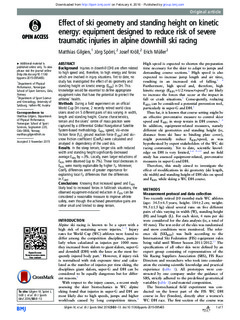| dc.contributor.author | Gilgien, Matthias | |
| dc.contributor.author | Spörri, Jörg | |
| dc.contributor.author | Kröll, Josef | |
| dc.contributor.author | Müller, Erich | |
| dc.date.accessioned | 2016-04-06T07:59:12Z | |
| dc.date.available | 2016-04-06T07:59:12Z | |
| dc.date.issued | 2016 | |
| dc.identifier.citation | British Journal of Sports Medicine. 2015, 50, 8-13. | nb_NO |
| dc.identifier.uri | http://hdl.handle.net/11250/2384140 | |
| dc.description | This is an Open Access article distributed in accordance with the Creative Commons Attribution Non Commercial (CC BY-NC 4.0) license, which permits others to distribute, remix, adapt, build upon this work non-commercially, and license their derivative works on different terms, provided the original work is properly cited and the use is non-commercial. See: http://creativecommons.org/licenses/by-nc/4.0/ | nb_NO |
| dc.description.abstract | Background: Injuries in downhill (DH) are often related to high speed and, therefore, to high energy and forces which are involved in injury situations. Yet to date, no study has investigated the effect of ski geometry and standing height on kinetic energy (EKIN) in DH. This knowledge would be essential to define appropriate equipment rules that have the potential to protect the athletes’ health.
Methods: During a field experiment on an official World Cup DH course, 2 recently retired world class skiers skied on 5 different pairs of skis varying in width, length and standing height. Course characteristics, terrain and the skiers’ centre of mass position were captured by a differential Global Navigational Satellite System-based methodology. EKIN, speed, ski–snow friction force (FF), ground reaction force (FGRF) and ski–snow friction coefficient (CoeffF) were calculated and analysed in dependency of the used skis.
Results: In the steep terrain, longer skis with reduced width and standing height significantly decreased average EKIN by ∼3%. Locally, even larger reductions of EKIN were observed (up to 7%). These local decreases in EKIN were mainly explainable by higher FF. Moreover, CoeffF differences seem of greater importance for explaining local FF differences than the differences in FGRF.
Conclusions: Knowing that increased speed and EKIN likely lead to increased forces in fall/crash situations, the observed equipment-induced reduction in EKIN can be considered a reasonable measure to improve athlete safety, even though the achieved preventative gains are rather small and limited to steep terrain. | nb_NO |
| dc.language.iso | eng | nb_NO |
| dc.publisher | BMJ Publishing Group | nb_NO |
| dc.title | Effect of ski geometry and standing height on kinetic energy: equipment designed to reduce risk of severe traumatic injuries in alpine downhill ski racing. | nb_NO |
| dc.type | Journal article | nb_NO |
| dc.type | Peer reviewed | nb_NO |
| dc.subject.nsi | VDP::Social science: 200 | nb_NO |
| dc.subject.nsi | VDP::Social science: 200::Social science in sports: 330 | nb_NO |
| dc.subject.nsi | VDP::Social science: 200::Social science in sports: 330::Other subjects within physical education: 339 | nb_NO |
| dc.source.journal | British Journal of Sports Medicine | nb_NO |
| dc.identifier.doi | 10.1136/bjsports-2015-095465 | |
| dc.description.localcode | Seksjon for fysisk prestasjonsevne / Department of Physical Performance | nb_NO |
